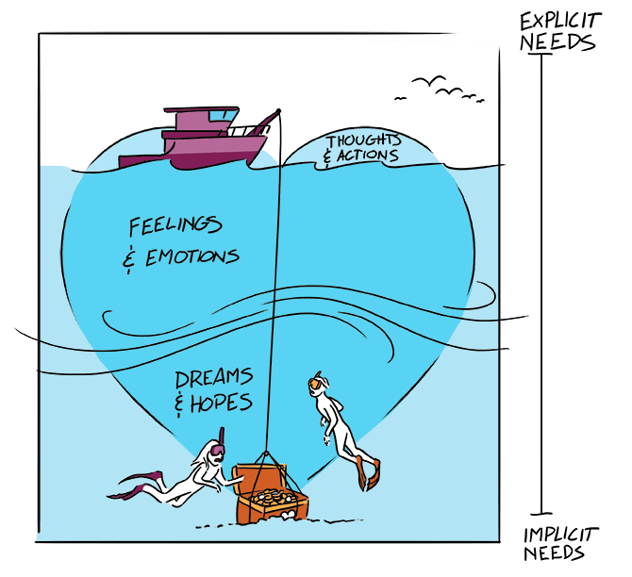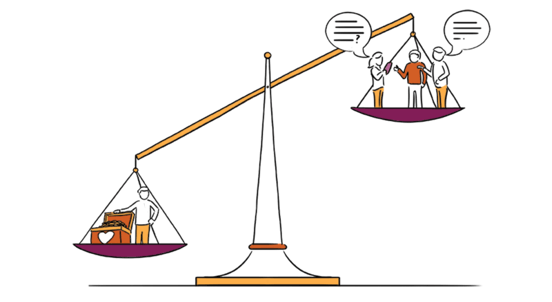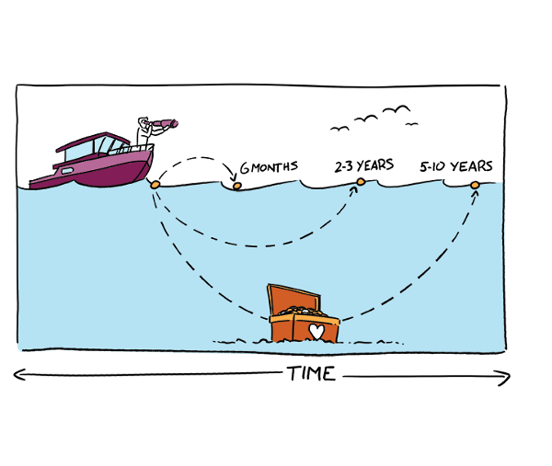
The types of user needs you capture can impact the future of your company
As Design Researchers, we spend a lot of time understanding and co-designing with people to explore their needs. We facilitate the co-creation of better services and experiences. The needs that we uncover inform insights that can improve current experiences or create new ones for the future. However, all needs are not equal.
Simply identifying a need does not automatically make it an insight. Needs can feed insights and become the foundation for design principles/ideal experience criteria — these can inform solutions to improve the future. But how far into the future are you hoping to go with the outcomes of your research? Determining the kind of end-user needs you aim to understand can have a dramatic effect on the findings and future of your organization.
When engaging in experience-based research and designing for the future, we believe it is important to first establish how far into the future you want to explore. Do you want to take a small step into uncovering short-term needs, or a bold leap to unearth needs that can impact the next five, ten or fifteen years? The questions you ask will determine the breadth of opportunities for innovation. When practicing human-centered, experience-based research and co-designing future possibilities with people, it is important to understand the different types of needs that can be discovered, and how they can impact your business.
Here we will outline some of the different types of needs we can uncover during the co-design process, how they can impact the future, and key considerations when discovering these needs.
Types of Needs
Let’s start by defining the different types of needs that can be uncovered to gain insight during exploratory and generative design research at the front-end of the design process. We can divide these needs into two broad categories, explicit and implicit.

Explicit needs:
Explicit needs are typically what people know off the tip of their tongue and can easily communicate verbally when asked a question, perhaps in an interview, or focus group:
Researcher: “What is the most important part of the shoe buying experience for you?”
User: “Trying on a pair of shoes before I buy them.”
Implicit needs:
Another type is called implicit needs because they are harder for people to express. They aren’t easily communicated verbally or might not have been identified by the person as a need. However, these can be uncovered by tapping into people’s emotions, feelings, hopes and dreams for the future, and analyzing what they share.
Implicit needs can be further broken down into two parts, tacit and latent knowledge.
Tacit knowledge is the stuff that is hard to verbalize or write down, an example might be trying to explain to someone how to maintain their balance while riding a bike.
Latent knowledge is the stuff that we don’t recognize now, but we will in the future.
Both need types require different approaches and will yield different outcomes in a short research session. Whichever approach you take will determine the usefulness of the results and how your company can use them in decision making.
Since most research sessions are limited to a short amount of time, for practical purposes, we need to use better methods/approaches to get to deeper needs, more quickly.
What Needs Should you Discover?
When you determine the questions you want to answer through your research, you are already determining how far into the future your research will impact your organization.
Extracting explicit needs from users will help generate insights that can allow you to get to immediate and near-term solutions. These solutions will often provide incremental improvements that will help optimize the experience faced by the user today. Following this explicit needs pathway can allow you to step into an improved experience by adapting and altering the present. For example, user experience researchers might leverage explicit needs or challenges users come across to improve a user interface. However, for strategic work, most solutions may not be rolled out for months or years so it doesn’t seem right to get near term answers if your service won’t reach customers for a while. Uncovering implicit needs can empower you to find areas that are relevant for the long-term and can be used to inform business decisions that can profoundly impact strategic direction.
Both explicit and implicit needs can be uncovered through generative design research methods and processes. These methods can empower users to create artifacts (with a custom toolkit) and express their explicit and implicit needs. To understand their implicit needs for the future you will need to further analyze what they create/make along with their narrative. It requires a lot more time and energy to deep dive and understand people’s implicit needs (emotional drivers, dreams and values).
3 Key Considerations Before You Embark on Discovering Needs through Generative Research:

1. Determine How Far into the Future You Want to Innovate
One question we ask our clients before we start a project is, “Do you want to take small steps toward innovation for the near future or make a leap into innovating for the distant future?” Knowing whether you want near term or long term impact from your research insights becomes a critical factor in how we approach a project.
2. Set the Level of Detail
If the needs are too high-level (e.g. “I need to exercise more”), nothing new will be discovered. If they are too granular, opportunities will be missed (e.g. “I pushed this button but it took me to the menu screen, not the check-out”). Establishing this at the beginning of the project ensures that the type of needs required will be discovered and successfully applied. Understanding how granular implicit versus explicit needs can take you can help determine what type of research your company could benefit from.
From here, we shift from design research concerns and move into design strategy concerns.
3. Translate Insights into Action
Simply discovering needs that provide key insights does not automatically lead to innovation. What you do with those insights makes a big difference. Turning design opportunities into actionable outcomes is an important step towards successfully creating products, services, and experiences that align with the future aspirations of your customers.
If you structure your research to go after the correct levels/types of needs, you will create successful opportunities to best support the design team’s creation of meaningful outcomes.
So the next time you are considering a design research effort to gain new insight and understanding, ask yourself, “How far into the future do we want to explore? How will this information be used in strategy and/or the design phase?” Answering these questions will determine what type of needs (be it explicit or implicit) you should go after and the way to go about it. It will ensure that the research outcomes are meeting your goals, be it near or long term insight.
Co-authored by Monica Weiler, Ph.D., Anthony Weiler, & David McKenzie, MFA.
Feel free to drop us a line at monica@thestratosgroup.com or @TheStratosGroup on Twitter. As always, you can find more on our website (www.thestratosgroup.com) and on our Medium blog profile (www.medium.com/@TheStratosGroup).


